Header image from National Park Service, Blue Ridge Parkway
North Carolina was the 12th state to ratify the U. S. Constitution and was admitted to the Union on November 21, 1789.
Bird: Cardinal
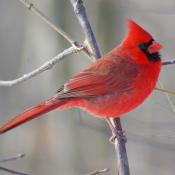
Unlike many other songbirds in North America, both the male and female cardinals can sing. Usually, only a male songbird is capable of singing. When a female cardinal sings from the nest, it usually means she’s telling the male she needs more food. Cardinals mate for life. A group of cardinals has many collective nouns, including a “college”, “conclave”, “deck”, “radiance”, and “Vatican” of cardinals.
The cardinal is the mascot of prominent sports teams and schools, including the St. Louis Cardinals (baseball) and Arizona Cardinals (football); it is the state bird of seven states, more than any other bird: Illinois, Indiana, Kentucky, North Carolina, Ohio, Virginia, West Virginia
Flower: Flowering Dogwood
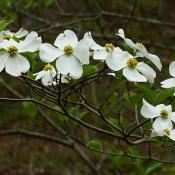
The term “dogwood winter”, in colloquial use in the American Southeast, is sometimes used to describe a cold snap in spring, presumably because farmers believed it was not safe to plant their crops until after the dogwoods blossomed. According to legend, Jesus Christ was crucified on a dogwood cross, after which God declared that dogwoods would again never grow tall enough for the construction of crucifixion crosses
One of the most interesting dogwood tree facts is that their roots are used to make dyes. There are several species of dogwood, the roots of which provide different color dyes. Specifically, dogwood roots provide red, black and yellow dyes. Additional colors can be created by mixing dogwood root with other plants that provide dyes. The wood from dogwood trees was previously used in the construction of wheels, weaving shuttles, hay forks and machine bearings. This is largely due to the fact that wood from the dogwood tree resists splitting, and wears smoothly and evenly. The wood is strong, dense, durable, and shock resistant. For these reasons, this particular wood is still used in the manufacture of items such as golf club heads, walking canes, tool handles, spindles and mallet heads.
Almost all parts of dogwood trees can be used for medicinal purposes: the bark, roots, berries, twigs, leaves and flowers. Native Americans used the root of dogwood trees to treat malaria. The inner bark of the roots contains the alkaloid known as cornin. Other ailments that have been treated with dogwood include insomnia, asthma, fevers, muscular problems, whooping cough, toothache and even canine mange. When supplies of quinine ran low during the Civil War, dogwood extract was used as a substitute.
Tree: Long leaf pine
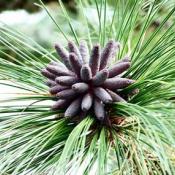
Long-leaf Pine – Vast forests of longleaf pine once were present along the southeastern Atlantic coast and Gulf Coast of North America, as part of the eastern savannas. These forests were the source of naval stores – resin, turpentine, and timber – needed by merchants and the navy for their ships. State tree of Alabama and North Carolina.
State Quarter
From theus50.com
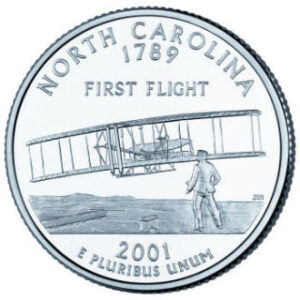 The North Carolina quarter highlights the famous 1903 photograph of the “First Flight”.
The North Carolina quarter highlights the famous 1903 photograph of the “First Flight”.
The North Carolina quarter commemorates the historic feat that took place on December 17, 1903, at Kitty Hawk, North Carolina with the first successful flight of a heavier-than-air, self-propelled flying machine. The craft, called the Flyer, traveled a distance of approximately 37 meters (120 feet) on its first flight and soared even further as one of the most significant human achievements in history.
Capital: Raleigh, North Carolina
Nickname: Tar Heel State
Beverage: Milk
Motto: To be rather than to seem.
The State of North Carolina has 42 official state emblems including the state insect (European honey bee), gemstone (emerald), beverage (milk), dog (Plott hound) , vegetable (sweet potato), fruit (Scuppernong grape), folk dance (clogging), and sport (Nascar).
North Carolina Facts and Trivia
North Carolina has 53,819 square miles; 560 North-South and 170 East-West.
The first English colony in America was located on Roanoke Island in 1585. Walter Raleigh founded it. The colony mysteriously vanished with no trace except for the word “Croatoan” scrawled on a nearby tree.
The first English child born in America was born in Roanoke in 1587. Her name was Virginia Dare.
In 1663 Charles II granted a charter for land south of Virginia on the condition the land be named for his father, Charles I. Carolina comes from Carolus, the Latin form of Charles.
Angered by the Navigation Acts, which imposed taxes on colonial goods, and the abuse of power flaunted by the customs collector and deputy governor, Thomas Miller, a group of about 40 rebels imprisoned Miller and seized control of local government in 1677. John Culpeper, one of the group’s leaders, was tried for treason in England, but was acquitted and returned to Albemarle. The uprising became known as Culpeper’s Rebellion.
Originally settlers poured in from Virginia. These were mostly common folks who disliked aristocratic Virginia. In the north, small farms prevailed while the southern colony grew wealthy from agriculture and slavery. Great plantations were formed. By 1690 the northern settlements began to be called North Carolina to distinguish it from the southern part.
In its early years as a colony, North Carolina settlements became an important source of the naval stores of tar, pitch, and turpentine, especially for the British navy. Tar and pitch were largely used to paint the bottom of wooden British ships both to seal the ship and to prevent shipworms from damaging the hull. It is from this reference that the state nickname became “Tar-heel”.
 The pirate Blackbeard, also known as Edward Teach, was killed off North Carolina’s Outer Banks. on Nov 22, 1718. Legend says he received 5 musket-ball wounds and 20 sword lacerations before his death. It is believed that Teach created design for the “pirate flag”.
The pirate Blackbeard, also known as Edward Teach, was killed off North Carolina’s Outer Banks. on Nov 22, 1718. Legend says he received 5 musket-ball wounds and 20 sword lacerations before his death. It is believed that Teach created design for the “pirate flag”.
One of the original 13 colonies, North Carolina was the first state to instruct its delegates to vote for independence from the British crown during the Continental Congress. Following the Revolutionary War, North Carolina developed an extensive slave plantation system and became a major exporter of cotton and tobacco, although the slave population remained relatively small compared to that of other southern states.
North Carolina ratified the Constitution November 21, 1789, becoming the 12th state.
The University of North Carolina Chapel Hill is the oldest State University in the United States. It was founded in 1795.
The first American gold rush began in Cabarrus County, North Carolina. in 1799. Young Conrad Reed, while playing in Little Meadow Creek, located on the Reed farm in southeastern Cabarrus County, found a gold chunk approximately the size of a shoe and weighing 17 pounds. His father John Reed took the nugget into Concord to a silversmith, who informed Reed that the rock did not have any value. The elder Reed returned home with it, holding it for three years until a trip in 1802 to Fayetteville, where he sold the “nugget” to a jeweler for $3.50. Over time John Reed learned that the jeweler sold the large nugget for several thousand dollars. Reed returned to Fayetteville insisting on more just compensation. This discovery and news of the sale spurred the beginning of gold mining in the area.
In 1861, North Carolina became one of 11 states to secede from the United States, beginning the American Civil War. Despite no major battles being fought in the state, North Carolina sent more recruits to fight for the Confederacy than any other rebel state.
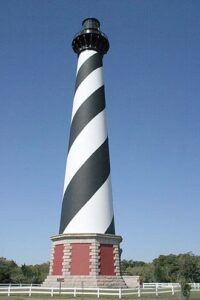 Cape Hatteras Light is a lighthouse located on Hatteras Island in the Outer Banks in the town of Buxton, North Carolina and is part of the Cape Hatteras National Seashore. It is the Tallest brick lighthouse in the U.S., second largest in the world. It was built in 1870, replacing one built in 1802 which was damaged during the Civil War. The Outer Banks are a group of barrier islands on the North Carolina coast that separate the Atlantic Ocean from the coastal sounds and inlets. Atlantic currents in this area made for excellent travel for ships, except in the area of Diamond Shoals, just offshore at Cape Hatteras. Nearby, the warm Gulf Stream ocean current collides with the colder Labrador Current, creating ideal conditions for powerful ocean storms and sea swells. The large number of ships that ran aground because of these shifting sandbars gave this area the nickname “Graveyard of the Atlantic.”
Cape Hatteras Light is a lighthouse located on Hatteras Island in the Outer Banks in the town of Buxton, North Carolina and is part of the Cape Hatteras National Seashore. It is the Tallest brick lighthouse in the U.S., second largest in the world. It was built in 1870, replacing one built in 1802 which was damaged during the Civil War. The Outer Banks are a group of barrier islands on the North Carolina coast that separate the Atlantic Ocean from the coastal sounds and inlets. Atlantic currents in this area made for excellent travel for ships, except in the area of Diamond Shoals, just offshore at Cape Hatteras. Nearby, the warm Gulf Stream ocean current collides with the colder Labrador Current, creating ideal conditions for powerful ocean storms and sea swells. The large number of ships that ran aground because of these shifting sandbars gave this area the nickname “Graveyard of the Atlantic.”
Pepsi was invented and first served in New Bern in 1898. A drugstore clerk named Caleb Bradham invented the drink and believed it aided digestion. The name “Pepsi” is from the word “dyspepsia” meaning upset stomach.
In 1903 the Wright Brothers made the first successful powered flight by man at Kill Devil Hill near Kitty Hawk. The Wright Memorial at Kitty Hawks now commemorates their achievement.
Greensboro is the birthplace of the famous Vicks Vapor Rub. Greensboro pharmacist Lunsford Richardson concocted the rub as a treatment for his son’s croup in 1905.
Babe Ruth hit his first professional home run in Fayetteville on March 7, 1914.
During prohibition, North Carolina earned the title of “Moonshine Capital of the World.” NASCAR racing has its origin in bootlegging of illicit products during the prohibition years.
Mt. Olive Pickles and the town of Mt. Olive have been inseparable since 1926. The company remains at the original site, and each New Year’s Eve residents and visitors can enjoy the town of Mt. Olive’s annual pickle drop.
Krispy Kreme Doughnut was founded in Winston-Salem in 1937.
The first Putt-Putt miniature golf course was built in Fayetteville in 1954.
North Carolina is the largest producer of sweet potatoes in the nation. Students at a Wilson County school petitioned the North Carolina General Assembly for the establishment of the sweet potato as the official state vegetable.
The Venus Fly-Trap is native to Hampstead.
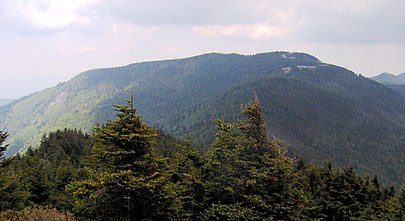 Mount Mitchell is the highest elevation in North Carolina and the highest peak east of the Mississippi River.
Mount Mitchell is the highest elevation in North Carolina and the highest peak east of the Mississippi River.
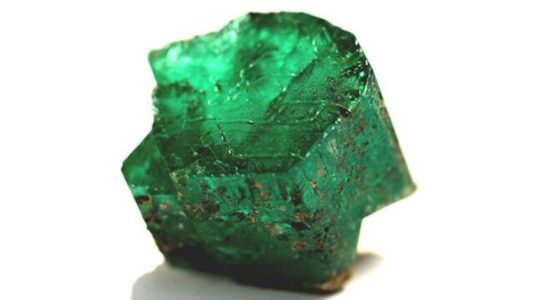 In 2009 the Carolina Emperor was found. It is a 310 caret emerald, believed to be the largest ever found in the U.S. The man who found it, Terry Lee Ledford, died in a mining accident in 2014.
In 2009 the Carolina Emperor was found. It is a 310 caret emerald, believed to be the largest ever found in the U.S. The man who found it, Terry Lee Ledford, died in a mining accident in 2014.
Reader’s Digest state jokes
On his first trip to Boston, the North Carolinian met a girl at a bar and asked her, “Do you go to Harvard?”
The girl responded, “Yale.”
“OK. DO YOU GO TO HARVARD?!”
Reader’s Digest most difficult towns in each state to pronounce
North Carolina: Schley
Trying to be Sly, are we, Schley, North Carolina? Or is that just the way you’re pronounced? The c h and e are silent.
Absurd And Strange Laws in North Carolina:
You may not use elephants to plow cotton fields.
It’s against the law to sing off key.
If a man and woman who aren’t married go to a hotel and register themselves as married, then according to state law, they are married
Famous People:
- Robert C. Byrd, politician
- David Brinkley, TV newscaster
- Howard Cosell, sportscaster
- Cecil B DeMille, director, producer
- Dale Earnhardt, racecar driver
- Elizabeth Hanford Dole, public official, wife of Robert Dole.
- Roberta Flack, singer
- Ava Gardner, actress
- Richard Gatling, inventor
- Billy Graham, evangelist
- Kathryn Grayson, singer, actress
- Andy Griffith, actor
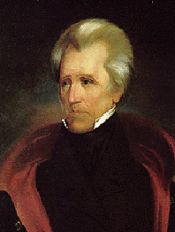 Andrew Jackson, seventh President of the United States, was born in the Waxsaws area on the border of North and South Carolina.
Andrew Jackson, seventh President of the United States, was born in the Waxsaws area on the border of North and South Carolina.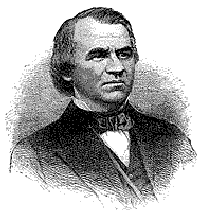 Andrew Johnson started his career as a tailor’s apprentice in Raleigh, North Carolina and rose to lead in the reuniting of the nation as the seventeenth President of the United States.
Andrew Johnson started his career as a tailor’s apprentice in Raleigh, North Carolina and rose to lead in the reuniting of the nation as the seventeenth President of the United States.- William Rufus King, Vice-President of the U. S., for President Franklin Pierce. Served only 45 days in 1853 – died of tuberculosis
- Charles Kuralt, TV journalist
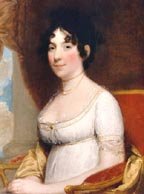 Dolley Payne Madison, first lady, wife of James Madison
Dolley Payne Madison, first lady, wife of James Madison- Ronni Milsap, country music singer
- Edward R. Murrow, commentator
- Arnold Palmer, recognized as the player whose aggressive play and winning personality raised golf to national attention, honed his skills on the championship golf team of Wake Forest University.
- Floyd Patterson, boxer
- Richard Petty, auto racer
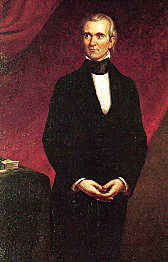 James K. Polk, born in Mecklenburg County, North Carolina, was the eleventh President of the United States.
James K. Polk, born in Mecklenburg County, North Carolina, was the eleventh President of the United States.- William Sydney Porter, aka O. Henry, author
- Soupy Sales, comedian
- Earl Scruggs, bluegrass musician
- Randy Travis, musician
- Thomas Clayton Wolfe, author
Music:
The Old North State (state song)
Carolina In My Mind by James Taylor
Carolina In the Morning by Al Jolson
Wagon Wheel by Old Crow Medicine Show
Carolina by Eric Church
Oh My Sweet Carolina by Ryan Adams with Emmylou Harris
Gone to Carolina by Shooter Jennings
Greensboro Woman by Townes Van Zandt
Carolina Girls by General Johnson and the Chairman of the Board
Credits:
See 50 states.com for more interesting facts and trivia about North Carolina.
See Mental Floss: 25 Delightful Facts About North Carolina by Kirstin Fawcett
See Wikipedia
See Ducksters.com
See History.com
See Only in Your State, especially if you are planning to travel in North Carolina.
See The Fact File.org

Pingback: The month of November